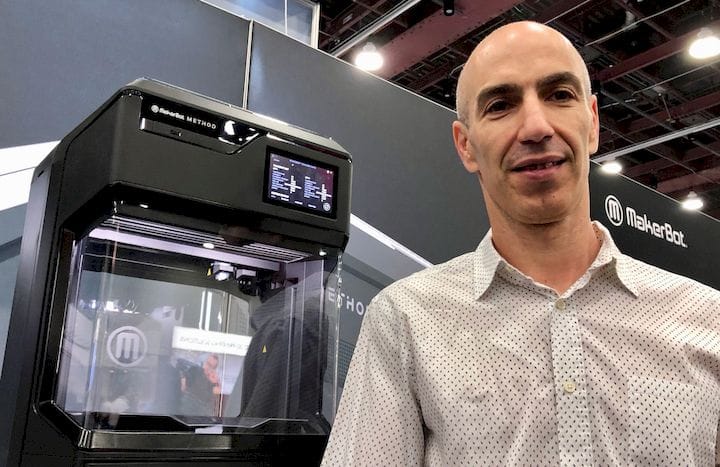![MakerBot’s Nadav Goshen [Source: Fabbaloo]](https://fabbaloo.com/wp-content/uploads/2020/05/makerbot-nadav-goshen-1_img_5eb0964f7cf76.jpg) MakerBot’s Nadav Goshen [Source: Fabbaloo]
MakerBot’s Nadav Goshen [Source: Fabbaloo]
We had a long chat with MakerBot CEO Nadav Goshen about the current state of the company and its products.
MakerBot, of course, is one of the most famous brands in all 3D printing, having been the company that brought forward to the general public the notion of desktop 3D printing in 2009. The idea then was to enable everyone to unleash their “inner maker”, and along the way sell a ton of machines to consumers.
Things didn’t quite turn out that way, as consumers really didn’t take up desktop 3D printing in the massive way everyone predicted at the time. As a result, most companies involved in consumer-based 3D printing at the time had to pivot to something else or die. MakerBot was one of them.
Goshen explains that MakerBot is technically still in the consumer 3D printing business, but it’s just that the market and products are not yet ready. He says for consumer success, things must be as simple “as a toothbrush”. Of course, we all know 3D printing is not quite that simple yet, but things are definitely moving in that direction, albeit slowly.
In the meantime MakerBot seems to have made not one, but two significant pivots.
MakerBot Pivots
First, they repositioned their products to address the education market. They leveraged not only the 3D printers on the product shelf, but also their massive 3D model repository, Thingiverse. They’ve provided a comprehensive student plan that apparently is being accepted widely, and today Goshen says MakerBot is the “number one provider to the education market in the US.”
While that pivot to education may have distressed many of the DIY 3D printer operators the company had previously attracted, it did allow MakerBot to survive the transition out of the consumer market.
Goshen explains that after that transition, the company in 2016 began examining its next steps and targeted the professional 3D printing market. This is a segment we’ve discussed many times, and it is in between consumer and industrial, typically composed of engineers, industrial designers and architects who use 3D printers intermittently in an office environment.
MakerBot felt, as we did, that this was a new market that could be addressed. However, after examining the needs of this market, MakerBot realized their existing product line would not properly address all the concerns. Thus they began development of an entirely new product, the MakerBot Method. This is the reason for the unexpected gap of product announcements from the company, which had previously announced something new almost every year.
The key to the Method, as Goshen has told us in previous conversations, is that it is capable of dimensional accuracy, far more than most typical desktop 3D printers. This is accomplished by their circulating heated build chamber. This feature ensures the entire print is at a consistent temperature during the build, not just the bottom layer or two as is done by machines with heated print plates.

The build chamber maintains a constant and consistently distributed heat envelope around the print to maintain its dimensionality when deposited by the Smart Extruders. Then, when the print completes, it emerges from the build chamber into the ambient air and uniformly cools and shrinks slightly in all axes. By carefully calculating the shrinkage rate, MakerBot can achieve highly consistent dimensionality using this approach — which, by the way, is very similar to what Stratasys does on their Fortus equipment.
![A 3D printed gripper made by the MakerBot Method [Source: Fabbaloo]](https://fabbaloo.com/wp-content/uploads/2020/05/image-asset_img_5eb096502c8be.jpg)
The results are pretty impressive. Here we see a gripper print. It’s one of those “print it assembled” style 3D models, but there are many requirements for precise dimensions to ensure the final print mechanically works and works smoothly. It does, we tested it.
Heated Build Chamber
Goshen explains he is frequently puzzled by those who ask why the Method does not include a heated build plate! The question is entirely ridiculous, as a fully heated — and circulating — chamber is a far superior solution to the shrinkage issue. It may be an indicator that many users don’t yet fully understand the technology.
Another major factor in producing such quality prints is the extensive use of sensors that can help the machine tune itself in real time. Here we see an image of some of the sensors used by the MakerBot Method, and there’s more on subsequent screens. This is one of the more instrumented devices we’ve seen, and especially for a desktop machine.
![Sensor values on the MakerBot Method [Source: Fabbaloo]](https://fabbaloo.com/wp-content/uploads/2020/05/image-asset_img_5eb0965077cae.jpg)
MakerBot has tweaked a number of other features that specifically address the professional market, such as reducing noise, increasing quality through enclosing and warming the filament materials, reducing downtime, and more.
MakerBot Introduces PETG
Recently they’ve even introduced PETG as a new material. While that’s certainly quite welcome, the choice of materials is something MakerBot could improve, as their competitors do offer wider choices — but not necessarily with as accurate prints.
![The MakerBot Method’s Smart Extruders are quite different [Source: Fabbaloo]](https://fabbaloo.com/wp-content/uploads/2020/05/image-asset_img_5eb09650c1b7a.jpg)
The Method is indeed different. While it sports a “Smart Extruder”, the extruder is actually quite different from the “Smart Extruders” found on their previous product lines. The new versions are specifically designed for the different properties required in professional usage, and are said to have reduced down time.
MakerBot seems to have a reasonable strategy here by adding a new market to their portfolio, and based on what we’ve seen with the Method, they could succeed.
It’s not your average MakerBot.
Via MakerBot

